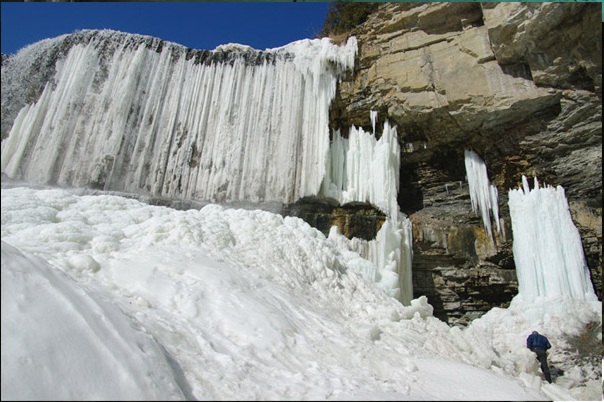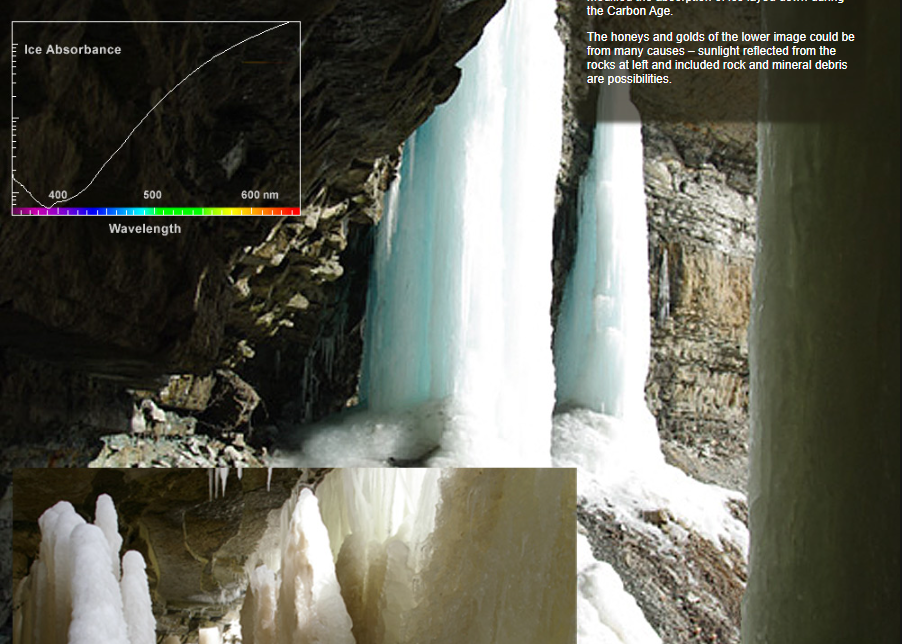Ice Colours
Ice Colours: Exploring the Astonishing Hues of Frozen Formations
Ice, often associated with its classic white appearance, can actually display a stunning array of colors. Early Arctic explorers were taken aback by the unexpected hues they encountered in icy landscapes. In this article, we delve into the captivating world of ice colors and explore the factors that contribute to their formation.
Pure ice, contrary to popular belief, is not entirely transparent. It possesses a slight ability to absorb long-wavelength light, as illustrated in the spectrum displayed at the lower left corner. Consequently, when light passes through a sufficiently thick section of ice, such as in an ice cave or behind a frozen waterfall, it can take on a bluish tint. This phenomenon is responsible for the ethereal turquoise shade observed in certain ice formations.
However, the coloration of ice is not solely influenced by its inherent properties. Various external factors come into play, altering its appearance in mesmerizing ways. For instance, the angle and intensity of incident light can dramatically modify the colors perceived. Sunrises and sunsets, with their distinctive lighting conditions, can create particularly striking effects on ice formations.
In addition to light manipulation, ice can also acquire its colors from included materials. During the formation of ice, various substances may become trapped within it, resulting in a spectrum of hues. Minerals ground from glaciers, finely divided soils, and even micro-organisms contribute to the color palette of ice formations. Furthermore, substances like soot, deposited during the Carbon Age, have been found to modify the absorption properties of ice.
The stunning honey and gold tones showcased in the lower image can be attributed to a multitude of causes. One possibility is sunlight reflecting off nearby rocks, casting warm hues onto the ice formations. Additionally, included rock and mineral debris can introduce a diverse range of colors, adding to the visual spectacle.
The exploration of ice colors unveils a world of endless fascination. Each turn and discovery reveals a new shape and a unique hue, captivating the observer with its ever-changing beauty. Whether it be the tranquil blues of an ice cave or the golden glow of a frozen waterfall, ice formations offer a visual feast for those fortunate enough to witness them.
As we continue to unravel the secrets of ice colors, the interplay between light, minerals, and other factors will undoubtedly provide further insights into the captivating world of atmospheric optics. The allure of these natural phenomena continues to inspire awe and wonder, reminding us of the boundless wonders that nature has in store for us. So, next time you encounter an ice formation, take a moment to appreciate the kaleidoscope of colors it may hold within its frozen embrace.

Ice Colours
Imaged by Lori & Peter Checkowy behind the Websters Waterfall near Hamilton Ontario, Canada on the Niagara Escarpment. ©Lori & Peter Checkowy, shown with permission.

AtmosphericOptics
About - Submit Optics Picture of the Day Galleries Previous Next Today Subscribe to Features on RSS Feed
OpticsPOD - Optics Picture of the Day - OPOD | Today - Galleries - Submit Image - Atmospheric Optics
"We were intrigued by the variety of shapes and hues of those huge Ice formations. We crawled behind the wall of frozen pillars and were simply awestruck. With every turn we discovered different shapes and colours. The end-section produced this amazing turquoise shade and in mid-section it was more a honey gold."
Early Arctic explorers were amazed by the colours of ice. They expected dazzling white and instead they saw all manner of wondrous hues.
Pure ice is not completely transparent. It slightly absorbs long wavelength light as shown in the spectrum at lower left. Therefore light shining through a thick enough section, as in an ice cave or behind a frozen waterfall, can appear bluish.
Other factors change its colours. The incident light modifies its appearance – sunrises and sunsets are extreme examples. And often the ice is coloured by included materials, minerals ground from glaciers, finely divided soils and micro-organisms. Soot has modified the absorption of ice layed down during the Carbon Age.
The honeys and golds of the lower image could be from many causes – sunlight reflected from the rocks at left and included rock and mineral debris are possibilities.


Note: this article has been automatically converted from the old site and may not appear as intended. You can find the original article here.
Reference Atmospheric Optics
If you use any of the definitions, information, or data presented on Atmospheric Optics, please copy the link or reference below to properly credit us as the reference source. Thank you!
-
<a href="https://atoptics.co.uk/blog/ice-colours-2/">Ice Colours</a>
-
"Ice Colours". Atmospheric Optics. Accessed on November 26, 2024. https://atoptics.co.uk/blog/ice-colours-2/.
-
"Ice Colours". Atmospheric Optics, https://atoptics.co.uk/blog/ice-colours-2/. Accessed 26 November, 2024
-
Ice Colours. Atmospheric Optics. Retrieved from https://atoptics.co.uk/blog/ice-colours-2/.